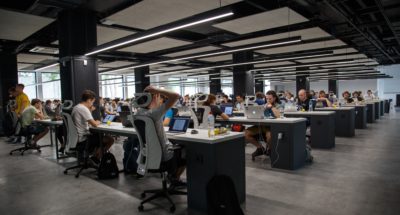
Reimagining the workplace
Intriguing innovation has opened up a “third space” to combine the advantages of the office and homeworking environments, suggest Johan Bjuregård and Peter Ingman, Co-Founders of Flowpass. ...

by Howard H. Yu Published 6 September 2022 in Innovation • 5 min read
Managing investor expectations is a required skill for CEOs of public companies. Even when markets are stable, closing the growth gap is often a struggle. A core mandate of the CEO is to raise the value of the company. Those who are perceived to be operating below the expected market level are putting themselves in jeopardy. Ultimately, managing and influencing investor expectations is about being future-ready. Future readiness can be a source of resilience but must be an ongoing process.
The onset of the pandemic raised two key points for CEOs in this regard. The first is that growth prospects are rooted in real capabilities. The pandemic showed us that those organizations who had successfully scaled those capabilities critical to future competitiveness could draw on them as a source of resilience during such exceptional circumstances.
The second point is that market turbulence should not distract from developing those capabilities; in fact, it should bring them into even sharper focus. Your core business still needs to be healthy, of course, but the ability to build up new capabilities is paramount.
Despite the unprecedented events of the last two years, share prices held steady for a significant period of time. This can largely be attributed to the stable macro-environment, and the stimulus packages implemented by governments around the world as the pandemic took hold. Now that those packages are falling away, share prices are reflecting the fear in the market. For those CEOs managing investor expectations on a tight budget – meaning potential cash flow or credit issues – these are worrying times.

“With the war in Ukraine and a growing sense of urgency surrounding monkeypox, not to mention rising political instability in the UK and uncertainty in relation to the forthcoming US midterms, it is difficult to chart a certain course”
All this tells us that a turbulent market will eventually catch up with unwary CEOs. With the war in Ukraine and a growing sense of urgency surrounding monkeypox, not to mention rising political instability in the UK and uncertainty in relation to the forthcoming US midterms, it is difficult to chart a certain course.
In the face of such uncertainty, investors are looking to the CEO for reassurance, firstly that management is in control and planning ahead. Management of earnings announcements plays a key role in this; investors need to understand that the fundamentals of a company’s business remains healthy, despite the external environment and is, therefore, in safe hands, and will be resilient to future shocks. It is also vital to demonstrate the ability to grow in adverse market conditions.
One thing CEOs must avoid is talking big in terms of execution and scaling and then failing to back that up with action. The pandemic illustrated that those firms who scale their capabilities can pivot much more easily under pressure than those who do not. The biggest danger for CEOs when it comes to managing expectations and influencing share price in such times is adopting a mindset of, “We need to retrench; we need to protect ourselves.” When such thinking sets in, CEOs stop R&D and capability building. Rather than protecting them, this makes them much more vulnerable.
It goes without saying that it’s critical to consider the long-term outlook for managing and influencing shareholder expectations. It is worthwhile regularly reviewing and, if necessary, revising the organization’s KPIs, reframing business objectives in terms of what will have greater value in the future market, such as ESG and DEI considerations.
One organization that does an excellent job of influencing investor expectations is Microsoft. CEO Satya Nadella is known for pushing his team to rethink KPIs in order to engage actively in the transformation of the organization in line with his vision for it. Nadella builds Microsoft’s shareholder messaging around those KPIs, and highlights evidence that the firm is on track.
Neither is Nadella afraid to learn from Microsoft’s peers. One example is the subscription model, which, in tech, was pioneered by Adobe in 2012. CEOs looking to manage investor expectations in the long term shouldn’t be afraid of studying and learning from other business models.
As part of this, you need to be comfortable to push your organization to build capabilities, scale new capabilities and redefine KPIs around those capabilities. If both internal and external shareholders are fully aware of the ongoing investment by the business in building these capabilities, they can feel secure in the future of their own investments in the business itself.

LEGO® Chair Professor of Management and Innovation at IMD
Howard Yu, hailing from Hong Kong, holds the title of LEGO® Professor of Management and Innovation at IMD. He leads the Center for Future Readiness, founded in 2020 with support from the LEGO Brand Group, to guide companies through strategic transformation. Recognized globally for his expertise, he was honored in 2023 with the Thinkers50 Strategy Award, recognizing his substantial contributions to management strategy and future readiness. At IMD, Howard directs the Strategy for Future Readiness and Business Growth Strategies programs.

11 September 2023 • by Johan Bjuregård, Peter Ingman in CEO Circle
Intriguing innovation has opened up a “third space” to combine the advantages of the office and homeworking environments, suggest Johan Bjuregård and Peter Ingman, Co-Founders of Flowpass. ...

17 February 2023 • by Susan Goldsworthy in CEO Circle
When senior employees at Dutch firm IG&H walked away in frustration with the company’s leadership, founder and CEO Jan van Hasenbroek realized that things had to change. Susan Goldsworthy, Affiliate Professor of Leadership,...

9 December 2022 • by Shlomo Ben-Hur, Steven Smith in CEO Circle
To retain the best and grow talent, organizations must recognize that learning and development is no longer a “nice to have”. ...

8 December 2022 • by Lars Häggström in CEO Circle
Much of the concern about workers disengaging from their jobs focuses on the younger generations. This misses an opportunity to consider how leaders can raise engagement across the workforce....
Explore first person business intelligence from top minds curated for a global executive audience